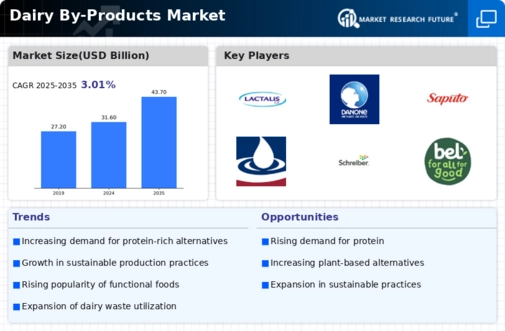Top Industry Leaders in the Dairy By Products Market

The Competitive Landscape of the Dairy By-Products Market is characterized by a mix of established industry players and emerging companies, reflecting the global demand for sustainable and value-added solutions in the dairy industry. As of 2023, key players in this market have strategically positioned themselves to address the challenges of waste reduction, sustainability, and the creation of innovative products from dairy by-products.
Key Players:
Nestle S.A. (Switzerland)
China Mengniu Dairy Company Ltd. (China)
Danone, Inc. (Canada) Groupe Lactalis S.A. (France)
Dairy Farmers of America, Inc. (U.S.)
Koninklijke FrieslandCampina NV (the Netherlands)
Groupe Lactalis S.A. (France)
Fonterra Co-operative Group Ltd. (New Zealand)
Inner Mongolia Yili Industrial Group Co., Ltd. (China)
Saputo Inc. (Canada)
Arla Foods amba (Denmark)
Strategies Adopted:
The Dairy By-Products Market revolve around waste reduction, value addition, and sustainability. Waste reduction strategies involve optimizing processing methods to extract the maximum value from dairy by-products, minimizing waste, and contributing to environmental sustainability. Value addition strategies include the development of innovative products and ingredients from dairy by-products, catering to the growing demand for functional and nutritional components in the food industry. Sustainability strategies encompass responsible sourcing, energy efficiency, and circular economy initiatives to enhance the overall environmental impact of dairy production.
Market Share Analysis:
The Dairy By-Products Market is influenced by factors such as the efficiency of by-product utilization, product quality, and sustainability practices. Companies that effectively utilize dairy by-products, extracting valuable components like proteins, fibers, and bioactive compounds, often secure larger market shares. The quality of by-products and the ability to convert them into high-value ingredients contribute to gaining consumer trust and loyalty. Sustainable practices, including waste reduction and energy generation from by-products, are becoming increasingly important in determining a company's competitive position.
New & Emerging Companies:
The Dairy By-Products Market contribute to the competitive landscape by exploring novel uses for by-products, introducing innovative technologies, and targeting niche applications. Start-ups such as MiTerro and The Mobius Company have entered the market, focusing on upcycling dairy by-products into sustainable materials and circular economy solutions. While these companies may initially have smaller market shares compared to established players, their emphasis on innovation and sustainability aligns with the evolving expectations of consumers.
Industry Trends:
Industry trends provide insights into ongoing developments within the Dairy By-Products Market. A notable trend in 2023 is the increased investment in research and development to discover new applications for dairy by-products, such as the development of sustainable packaging materials and bio-based polymers. Key players are actively exploring partnerships with research institutions and startups to drive innovation and enhance the marketability of dairy by-products.
Competitive Scenario:
The Dairy By-Products Market remains dynamic, with companies adopting diverse strategies to stay at the forefront of this rapidly evolving industry. Digital marketing and communication channels are becoming essential for companies to convey their commitment to sustainability and highlight the value proposition of their dairy by-products. Collaborations with sustainability-focused organizations and participation in industry initiatives contribute to expanding market visibility and reinforcing the commitment to environmental responsibility.
Recent Development
The Dairy By-Products Market is the increased focus on traceability and transparency. Key players are investing in technologies to trace the journey of dairy by-products from farm to final product, providing consumers with information on sourcing practices, production methods, and sustainability efforts. This development aligns with the broader trend of consumer demand for transparency and ethical considerations in the food industry.


